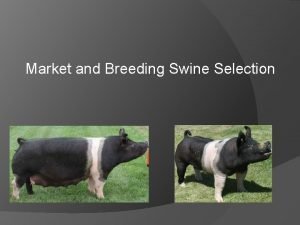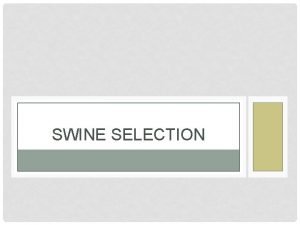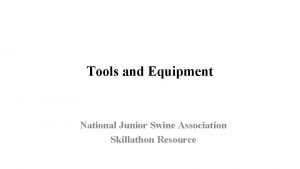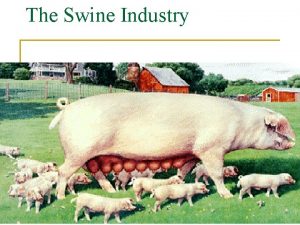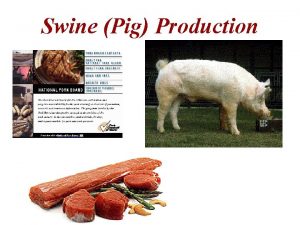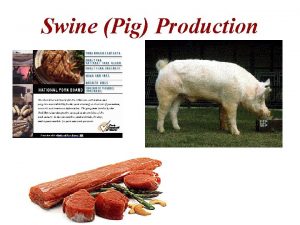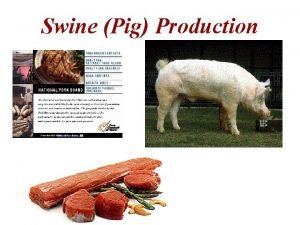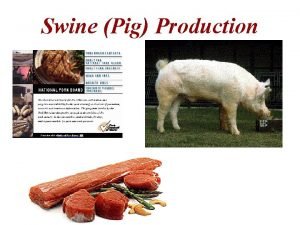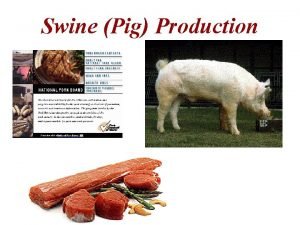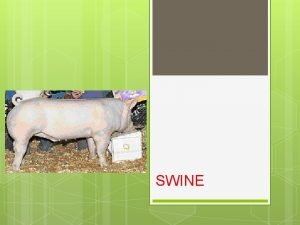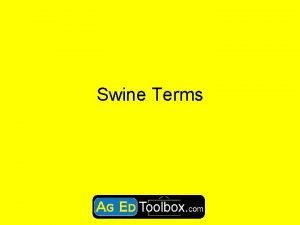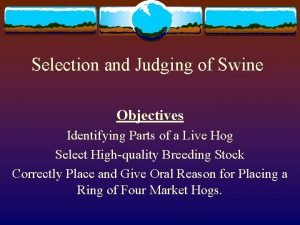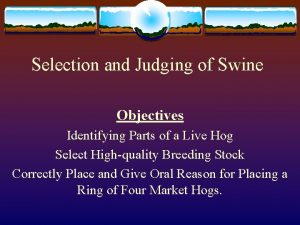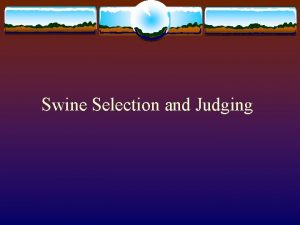SWINE SELECTION PARTS OF THE PIG In order















- Slides: 15

SWINE SELECTION

PARTS OF THE PIG • In order to be successful in selection of swine one must be familiar with the parts of the pig.

MUSCLING • Muscling is one of the most important traits in a market animal and is also the easiest to evaluate. • Muscle is what you are selling to the consumer; therefore, only pigs with above–average muscle thickness should be selected. • Muscling is best evaluated by examining the hog from the ground up and from the rear forward. • Heavy and well-muscled pigs will have a square, expressive shape when viewed from behind, with a deep groove down their top and a thick, full hip and ham. • A light-muscled pig will have an inverted “V” shape when viewed from the rear.

MUSCLING • The following are examples of a heavily muscled pig, a well-muscled pig, and a very light-muscled pig.

GROWTH, RIB CAPACITY AND VOLUME • DO NOT select a pig with any obvious defects. • The following are pictures of defects depicting a hernia to a humped back.

GROWTH • Small frame and Large frame pigs will generally grow slower. • A medium frame would be better. • Secondary indicators of growth include the length of the body, length of the cannon bone (collectively referred to as frame), cannon bone circumference, and rib capacity/volume

GROWTH • Narrow-chested pigs with little body capacity and small cannon bone circumference will tend to grow slowly and smaller.

GROWTH/RIB CAPACITY AND VOLUME • The first (left) pig exhibits the indicators of a pig that will be a good project. Note the strait back, square rump and grove in the back. • The second pig is a low volume pig that could be slow grower. • The third pig is a short bodied and short boned pig which will likely be a slow grower.

GROWTH/RIB CAPACITY AND VOLUME • (Left)a pig with secondary indicators of growth that suggest it should be a nice project. • A lower-volumed pig that will likely remain lean to a heavy weight and will likely be too slow–growing • A pig that is too wide-chested, big-bodied barrow on the right.

DESIGN/FEET AND LEG SOUNDNESS • A correctly structured, well-designed pig with all joints at the proper angles will walk effortlessly and athletically, as if all the pieces fit together. • The pig should hold its head up, have a level top line when walking, have clean joints with no evidence of swelling, and place its feet on all four corners of its body.

DESIGN/FEET AND LEG SOUNDNESS • Pigs with structural problems should be selected against. • The pig on the left has a correct angle to the shoulder, knee, and pastern. • The pig in the middle is very straight-shouldered, over at the knee, and straight-pasterned. • The pig on the right has excessive slope to the shoulder, is set too far back at the knee, and is weak-pasterned.

DESIGN/FEET AND LEG SOUNDNESS • (Left) A pig with the correct set to the hip, hock and pastern. • A pig that is very straight from the hock to the pastern. • (Right) A pig that has excessive set to the hock and is weak-pasterned.

DESIGN/FEET AND LEG SOUNDNESS • • • (Left) A foot with even-sized toes and a slight spread. A foot with an ulceration above the toe and swelling around the knee. A foot with a much smaller inside toe. This hock shows swelling on the right hock. (Right) This hock shows swelling on the inside left hock.

DESIGN/FEET AND LEG SOUNDNESS • Important!!!!! • Select for a hog that has a big foot and big cannon bone. • The are indicators of potential growth and expressiveness. • Look at the FEET!!!!

SHOW BREEDS
 Swine selection
Swine selection External part of swine
External part of swine 1st order 2nd order 3rd order neurons
1st order 2nd order 3rd order neurons Balancing selection vs stabilizing selection
Balancing selection vs stabilizing selection Similarities
Similarities K selection r selection
K selection r selection Natural selection vs artificial selection
Natural selection vs artificial selection Difference between continuous and discontinuous variation
Difference between continuous and discontinuous variation Stabilizing selection human birth weight
Stabilizing selection human birth weight Logistic model of population growth
Logistic model of population growth Natural selection vs artificial selection
Natural selection vs artificial selection Two way selection and multiway selection
Two way selection and multiway selection Multiway selection
Multiway selection Mass selection and pure line selection
Mass selection and pure line selection National junior swine association
National junior swine association Integumentary system of swine
Integumentary system of swine
